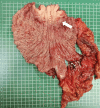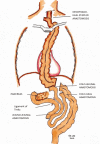Proximal Margin Involvement Following Total Gastrectomy for Seiwert III Adenocarcinoma: A Management Dilemma
- PMID: 39156343
- PMCID: PMC11330690
- DOI: 10.7759/cureus.64945
Proximal Margin Involvement Following Total Gastrectomy for Seiwert III Adenocarcinoma: A Management Dilemma
Abstract
Oesophagogastric junction carcinoma is now being increasingly regarded as a distinct site of neoplasia, separate from its adjacent sites. Recent advances in multimodal treatment approaches, including endoscopic procedures, oesophagectomy with three-field lymph node dissection, and definitive chemoradiotherapy, have significantly improved overall patient survival rates. Despite these advancements, the recurrence rate remains around 50% within one to three years following initial surgery. A major challenge in management arises when the resected surgical margins are involved with cancer. We present a 55-year-old man who experienced progressive dysphagia and, upon further assessment, was noted to have a Siewert III oesophagogastric junction adenocarcinoma. He underwent neoadjuvant chemotherapy before undergoing total gastrectomy with D2 lymphadenectomy with a Roux-en-Y reconstruction. Histopathological examination of the resected specimen revealed a positive proximal margin involvement. After optimization, he then underwent a salvage three-field McKeown oesophagectomy with colonic conduit reconstruction and adjuvant chemotherapy. Salvage surgery can be considered for patients with locoregional recurrence after definitive chemoradiotherapy or surgery. Other options include salvage chemoradiotherapy. Our case outlines the importance of proper patient selection for salvage surgery and highlights the choices of conduit in patients undergoing total esophagectomy post gastrectomy. In conclusion, managing proximal margin involvement of cardioesophageal junction adenocarcinoma remains a complex and multifaceted challenge, necessitating a tailored, multidisciplinary approach. The decision-making process must consider the patient's functional status, previous treatments, and specific anatomical considerations.
Keywords: colonic conduit; junctional cancer; poorly differentiated adenocarcinoma; prehabilitation; salvage surgery.
Copyright © 2024, Sadu Singh et al.
Conflict of interest statement
Human subjects: Consent was obtained or waived by all participants in this study. Conflicts of interest: In compliance with the ICMJE uniform disclosure form, all authors declare the following: Payment/services info: All authors have declared that no financial support was received from any organization for the submitted work. Financial relationships: All authors have declared that they have no financial relationships at present or within the previous three years with any organizations that might have an interest in the submitted work. Other relationships: All authors have declared that there are no other relationships or activities that could appear to have influenced the submitted work.
Figures




References
-
- Oesophageal cancer: ESMO Clinical Practice Guideline for diagnosis, treatment and follow-up. Obermannová R, Alsina M, Cervantes A, et al. Ann Oncol. 2022;33:992–1004. - PubMed
-
- Classification of adenocarcinoma of the oesophagogastric junction. Siewert JR, Stein HJ. Br J Surg. 1998;85:1457–1459. - PubMed
-
- Short-term outcomes of inflammatory bowel disease after Roux-en-Y gastric bypass vs sleeve gastrectomy. Heshmati K, Lo T, Tavakkoli A, Sheu E. J Am Coll Surg. 2019;228:893–901. - PubMed
-
- Clinical impact of FDG PET/CT in alimentary tract malignancies: an updated review. Akin EA, Qazi ZN, Osman M, Zeman RK. Abdom Radiol (NY) 2020;45:1018–1035. - PubMed
Publication types
LinkOut - more resources
Full Text Sources
Research Materials
